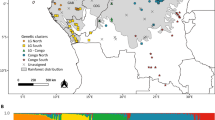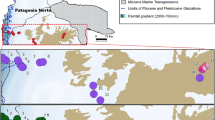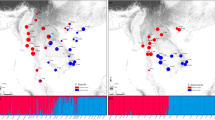Abstract
Members of the Euphorbiaceae are ecologically important elements of Southeast Asian forests. Species of the pioneer tree genus Macaranga, which is also known for its association with ants, are often abundant in disturbed areas. Phylogenetic studies suggested a recent radiation of section Pachystemon which comprises the majority of obligate myrmecophytes within Macaranga. In the present study, we analyzed the genetic structure of three closely related species of this section (M. constricta, M. griffithiana, and M. motleyana) with the aim of resolving their controversial taxonomy and historical biogeography. Chloroplast DNA haplotypes proved to be species-specific and showed a strong phylogeographic pattern. Nuclear microsatellite data supported the taxonomic distinctness of M. griffithiana and M. motleyana, but gave ambiguous results for M. constricta. Genetic differentiation was stronger each within M. griffithiana and M. motleyana than between M. constricta and M. griffithiana, highlighting problems of defining species boundaries. We found no indication for introgression or hybridization events. The high intraspecific morphological variation of the Bornean endemic M. motleyana was partly reflected by similar patterns of genetic variation. The pronounced genetic structure indicates a comparatively long diversification for this species. In contrast, the weak genetic differentiation within M. griffithiana, as well as the widespread distribution of its most common chloroplast haplotype from peninsular Malaysia up to Indochina, indicates a recent expansion in this area. Despite their morphological similarity and close relatedness, all species possess their own specific ant-partners with a corresponding distribution pattern.





Similar content being viewed by others
References
Baier, C., Guicking, D., Prinz, K., Fey-Wagner, C., Wöhrmann, T., Weising, K., Debener, T., et al. (2009). Isolation and characterization of 11 new microsatellite markers for Macaranga (Euphorbiaceae). Molecular Ecology Resources, 9, 1049–1052.
Bänfer, G., Fiala, B., & Weising, K. (2004). AFLP analysis of phylogenetic relationships among myrmecophytic species of Macaranga (Euphorbiaceae) and their allies. Plant Systematics and Evolution, 249, 213–231.
Bänfer, G., Moog, U., Fiala, B., Mohamed, M., Weising, K., & Blattner, F. R. (2006). A chloroplast genealogy of myrmecophytic Macaranga species (Euphorbiaceae) in Southeast Asia reveals hybridization, vicariance and long-distance dispersals. Molecular Ecology, 15, 4409–4424.
Bendiksby, M., Schumacher, T., Gussarova, G., Nais, J., Mat-Salleh, K., Sofiyanti, N., Madulid, D., et al. (2010). Elucidating the evolutionary history of the Southeast Asian holoparasitic, giant-flowered Rafflesiaceae: Pliocene vicariance, morphological convergence and character displacement. Molecular Phylogenetics and Evolution, 57, 620–633.
Blaimer, B. B. (2012). Acrobat ants go global: origin, evolution and systematics of the genus Crematogaster (Hymenoptera: Formicidae). Molecular Phylogenetics and Evolution, 65, 421–436.
Blattner, F. R., Weising, K., Bänfer, G., Maschwitz, U., & Fiala, B. (2001). Molecular analysis of phylogenetic relationships among myrmecophytic Macaranga species (Euphorbiaceae). Molecular Phylogenetics and Evolution, 19, 331–344.
Cannon, C. H., Morley, R. J., & Bush, A. B. G. (2009). The current refugial rainforests of Sundaland are unrepresentative of their biogeographic past and highly vulnerable to disturbance. Proceedings of the National Academy of Sciences of the United States of Ameica, 106, 11188–11193.
Chomicki, G., & Renner, S. S. (2015). Phylogenetics and molecular clocks reveal the repeated evolution of ant-plants after the late Miocene in Africa and the early Miocene in Australasia and the Neotropics. New Phytologist, 20, 411–424.
Clement, M., Posada, D., & Crandall, K. A. (2000). TCS: a computer program to estimate gene genealogies. Molecular Ecology, 9, 1657–1659.
Davies, S. J. (2001). Systematics of Macaranga sections Pachystemon and Pruinosae (Euphorbiaceae). Harvard Papers in Botany, 6, 371–448.
Davies, S. J., Lum, S. K. Y., Chan, R., & Wang, L. K. (2001). Evolution of myrmecophytism in western Malesian Macaranga (Euphorbiaceae). Evolution, 55, 1542–1559.
Drummond, A. J., Suchard, M. A., Xie, D., & Rambaut, A. (2012). Bayesian phylogenetics with BEAUti and the BEAST 1.7. Molecular Biology and Evolution, 29, 1969–1973.
Duminil, J., Kenfack, D., Viscosi, V., Grumiau, L., & Hardy, O. J. (2012). Testing species delimitation in sympatric species complexes: the case of an African tropical tree, Carapa spp. (Meliaceae). Molecular Phylogenetics and Evolution, 62, 275–285.
Earl, D. A., & von Holdt, B. M. (2012). STRUCTURE HARVESTER: a website and program for visualizing STRUCTURE output and implementing the Evanno method. Conservation Genetics Resources, 4, 359–361.
El Mousadik, A., & Petit, R. J. (1996). High level of genetic differentiation for allelic richness among populations of the argan tree (Argania spinosa (L) Skeels) endemic to Morocco. Theoretical and Applied Genetics, 9, 832–839.
Evanno, G., Regnaut, S., & Goudet, J. (2005). Detecting the number of clusters of individuals using the software structure: a simulation study. Molecular Ecology, 14, 2611–2620.
Excoffier, L., Smouse, P. E., & Quattro, J. M. (1992). Analysis of molecular variance inferred from metric distances among DNA haplotypes: application to human mitochondrial DNA restriction data. Genetics, 131, 479–491.
Excoffier, L., Laval, G., & Schneider, S. (2005). Arlequin (version 3.0): an integrated software package for population genetics data analysis. Evolutionary Bioinformatics Online, 1, 47–50.
Falush, D., Stephens, M., & Pritchard, J. K. (2003). Inference of population structure using multilocus genotype data: linked loci and correlated allele frequencies. Genetics, 16, 1567–1587.
Feldhaar, H., Fiala, B., Gadau, J., Mohamed, M., & Maschwitz, U. (2003a). Molecular phylogeny of Crematogaster subgenus Decacrema ants (Hymenoptera: Formicidae) and the colonization of Macaranga (Euphorbiaceae) trees. Molecular Phylogenetics and Evolution, 27, 441–452.
Feldhaar, H., Fiala, B., Hashim, R., & Maschwitz, U. (2003b). Patterns of the Crematogaster-Macaranga association: the ant partner makes the difference. Insectes Sociaux, 50, 9–19.
Feldhaar, H., Gadau, J., & Fiala, B. (2010). Speciation in obligately plant-associated Crematogaster ants: host distribution rather than adaption towards specific hosts drives the process. In M. Glaubrecht (Ed.), Evolution in action—adaptive radiations and the origins of biodiversity (pp. 193–213). Heidelberg: Springer.
Fiala, B., Maschwitz, U., Tho, Y. P., & Helbig, A. J. (1989). Studies of a Southeast Asian ant-plant association: protection of Macaranga trees by Crematogaster borneensis. Oecologia, 79, 463–470.
Fiala, B., Grunsky, H., Maschwitz, U., & Linsenmair, K. E. (1994). Diversity of ant-plant interactions: protective efficacy in Macaranga species with different degrees of ant association. Oecologia, 97, 186–192.
Fiala, B., Jakob, A., Maschwitz, U., & Linsenmair, K. E. (1999). Diversity, evolutionary specialization and geographic distribution of a mutualistic ant-plant complex: Macaranga and Crematogaster in South East Asia. Biological Journal of the Linnean Society, 66, 305–331.
Fiala, B., Meyer, U., Hashim, R., & Maschwitz, U. (2011). Pollination systems in pioneer trees of the genus Macaranga (Euphorbiaceae) in Malaysian rainforests. Biological Journal of the Linnean Society, 103, 935–953.
Goudet, J. (2002). FSTAT, a program to estimate and test gene diversities and fixation indices version 2.9.3.2. http://www2.unil.ch/popgen/softwares/fstat.htm.
Guicking, D., Rana, T. S., Blattner, F. R., & Weising, K. (2006). Microsatellite markers for the palaeotropic pioneer tree genus Macaranga (Euphorbiaceae) and their cross-species transferability. Molecular Ecology Notes, 6, 245–248.
Guicking, D., Kröger-Kilian, T., Weising, K., & Blattner, F. R. (2008). Single nucleotide sequence analysis: a cost- and time-effective protocol for the analysis of microsatellite- and indel-rich chloroplast DNA regions. Molecular Ecology Resources, 8, 62–65.
Guicking, D., Fiala, B., Blattner, F. R., Slik, F., Mohamed, M., & Weising, K. (2011). Comparative chloroplast DNA phylogeography of two tropical pioneer trees, Macaranga gigantea and Macaranga pearsonii (Euphorbiaceae). Tree Genetics & Genomes, 7, 573–583.
Guicking, D., Fiala, B., Kröger-Kilian, T., Mohamed, M., & Weising, K. (2013). High gene flow in two thrips-pollinated Southeast Asian pioneer trees: genetic diversity and population structure of Macaranga hypoleuca and Macaranga beccariana (Euphorbiaceae). Botanical Journal of the Linnean Society, 173, 606–621.
Heckroth, H. P., Fiala, B., Gullan, P. J., Idris, A. H., & Maschwitz, U. (1998). The soft scale (Coccidae) associates of Malaysian ant-plants. Journal of Tropical Ecology, 14, 427–443.
Iwanaga, H., Teshima, K. M., Khatab, I. A., Inomata, N., Finkeldey, R., Siregar, I. Z., Siregar, U. J., & Szmidt, A. E. (2012). Population structure and demographic history of a tropical lowland rainforest tree species Shorea parvifolia (Dipterocarpaceae) from Southeastern Asia. Ecology and Evolution, 2, 1663–1675.
Kamiya, K., Nanami, S., Kenzo, T., Yoneda, R., Diway, B., Chong, L., Azani, M. A., et al. (2012). Demographic history of Shorea curtisii (Dipterocarpaceae) inferred from chloroplast DNA sequence variations. Biotropica, 44, 577–585.
Kimura, M., & Ohta, T. (1978). Stepwise mutation model and distribution of allelic frequencies in a finite population. Proceedings of the National Academy of Sciences of the United States of Ameica, 75, 2868–2872.
Kulju, K. K. M., Sierra, S. E. C., Draisma, S. G. A., Samuel, R., & van Welzen, P. C. (2007). Molecular phylogeny of Macaranga, Mallotus, and related genera (Euphorbiaceae s.s.): insights from plastid and nuclear DNA sequence data. American Journal of Botany, 94, 1726–1743.
Leonard, J. A., den Tex, R.-J., Hawkins, M. T. R., Muñoz-Fuentes, V., Thorington, R., & Maldonado, J. E. (2015). Phylogeography of vertebrates on the Sunda Shelf: a multi-species comparison. Journal of Biogeography, 42, 871–879.
Maschwitz, U., Fiala, B., & Dumpert, K. (2004). An unusual myrmecophytic Macaranga association, occurring in a disjunct area in the monsoon zone of South-East Asia: phenology and the description of a new ant species. Ecotropica, 10, 33–49.
Morley, R. J. (2000). Origin and evolution of tropical rain forests. Chichester: Wiley.
Nei, M. (1987). Molecular evolutionary genetics. New York: Columbia University Press.
Ohtani, M., Kondo, T., Tani, N., Ueno, S., Lee, L. S., Ng, K., et al. (2013). Nuclear and chloroplast DNA phylogeography reveals Pleistocene divergence and subsequent secondary contact of two genetic lineages of the tropical rainforest tree species Shorea leprosula (Dipterocarpaceae) in South-East Asia. Molecular Ecology, 22, 2264–2279.
Pritchard, J. K., Stephens, M., & Donnelly, P. (2000). Inference of population structure using multilocus genotype data. Genetics, 155, 945–959.
Quek, S. P., Davies, S. J., Itino, T., & Pierce, N. E. (2004). Codiversification in an ant-plant mutualism: stem texture and the evolution of host use in Crematogaster (Formicidae: Myrmicinae) inhabitants of Macaranga (Euphorbiaceae). Evolution, 58, 554–570.
Quek, S. P., Davies, S. J., Ashton, P. S., Itino, T., & Pierce, N. E. (2007). The geography of diversification in mutualistic ants: a gene’s-eye view into the Neogene history of Sundaland rain forests. Molecular Ecology, 16, 2045–2062.
Raes, N., Cannon, C. H., Hijmans, R. J., Piessens, T., Saw, L. G., van Welzen, P. C., & Slik, J. W. F. (2014). Historical distribution of Sundaland’s Dipterocarp rainforests at Quaternary glacial maxima. Proceedings of the National Academy of Sciences of the United States of Ameica, 111, 16790–16795.
Raymond, M., & Rousset, F. (1995). Genepop (version 1.2): population genetics software for exact tests and ecumenicism. Journal of Heredity, 86, 248–249.
Rosell, J. A., Olson, M. E., Weeks, A., De-Nova, J. A., Lemos, R. M., Camacho, J. P., Feria, T. P., et al. (2010). Diversification in species complexes: tests of species origin and delimitation in the Bursera simaruba clade of tropical trees (Burseraceae). Molecular Phylogenetics and Evolution, 57, 798–811.
Slik, J. W. F., Poulsen, A. D., Ashton, P. S., Cannon, C. H., Eichhorn, K. A. O., Kartawinata, K., Lanniari, L., et al. (2003a). A floristic analysis of the lowland dipterocarp forests of Borneo. Journal of Biogeography, 30, 1517–1531.
Slik, J. W. F., Keßler, P. J. A., & van Welzen, P. C. (2003b). Macaranga and Mallotus species (Euphorbiaceae) as indicators for disturbance in the mixed lowland dipterocarp forest of East Kalimantan (Indonesia). Ecological Indicators, 2, 311–324.
Slik, J. W. F., Aiba, S.-I., Bastian, M., Brearley, F. Q., Cannon, C. H., Eichhorn, K. A. O., Fredriksson, G., et al. (2011). Soils on exposed Sunda Shelf shaped biogeographic patterns in the equatorial forests of Southeast Asia. Proceedings of the National Academy of Sciences of the United States of Ameica, 108, 12343–12347.
Ueda, S., Quek, S. P., Itioka, T., Inamori, K., Sato, Y., Murase, K., & Itino, T. (2008). An ancient tripartite symbiosis of plants, ants and scale insects. Proceedings of the Royal Society of London B, 275, 2319–2326.
van Welzen, P. C., Strijk, J. S., van Konijnenburg-van Cittert, J. H. A., Nucete, M., & Merckx, V. S. F. T. (2014). Dated phylogenies of the sister genera Macaranga and Mallotus (Euphorbiaceae): congruence in historical biogeographic patterns? PloS One, 9(1), e85713. doi:10.1371/journal.pone.0085713.
Vogel, M., Bänfer, G., Moog, U., & Weising, K. (2003). Development and characterization of chloroplast microsatellite markers in Macaranga (Euphorbiaceae). Genome, 46, 845–857.
Voris, H. K. (2000). Maps of Pleistocene sea levels in Southeast Asia: shorelines, river systems and time durations. Journal of Biogeography, 27, 1153–1167.
Weising, K., & Gardner, R. C. (1999). A set of conserved PCR primers for the analysis of simple sequence repeat polymorphisms in chloroplast genomes of dicotyledonous angiosperms. Genome, 42, 9–19.
Weising, K., Guicking, D., Fey-Wagner, C., Kröger-Kilian, T., Wöhrmann, T., Dorstewitz, W., Bänfer, G., et al. (2010). Mechanisms of speciation in Southeast Asian ant-plants of the genus Macaranga (Euphorbiaceae). In M. Glaubrecht (Ed.), Evolution in action—adaptive radiations and the origins of biodiversity (pp. 169–191). Berlin: Springer.
Whitmore, T. C. (1974). Studies in Macaranga VI. Novelties form Borneo and a reduction in Malaya. Kew Bulletin, 29, 445–450.
Whitmore, T. C. (1982). Macaranga Thou. Kew Bulletin, 36, 312–323.
Whitmore, T. C. (1984). Tropical rain forests of the Far East (2nd ed.). Oxford: Oxford University Press.
Whitmore, T. C. (2008). The genus Macaranga: a prodromus. Kew: Royal Botanic Gardens.
Whitmore, T. C., & Airy Shaw, H. K. (1971). Studies in Macaranga VI. New and notable records for Malaya. Kew Bulletin, 25, 238.
Acknowledgments
Permission to conduct research in Malaysia was kindly granted by the Economic Planning Unit (EPU), Kuala Lumpur and EPU in Kota Kinabalu, Sabah, as well as by the Danum Valley Management Committee and the Forest Department, Sarawak. We thank our colleagues in Malaysia, especially Dr. Rosli bin Hashim, Dr. Jamili Nais, Dr. Maklarin bin Lakim, and Dr. G. Reynolds for their support. We also thank LIPI for providing research permits for East Kalimantan, and our counterpart Kade Sidiyasa, who sadly passed away recently, and the Tropenbos Foundation for logistic help on site. Financial support by the German Research Foundation is gratefully acknowledged (grant We 1830/4, Fi 606/5). We thank Prof. Dr. K. E. Linsenmair for manifold support, Dr. K. Khoshbakht for the help with the molecular analyses, and Dr. N. Ruppert, M. Zirpel, Dr. T. Kenzo, Forestry and Forest Products Research Institute, and the Forest-Wildlife Research and Development Institute, Cambodia, for the supply of plant material. Dr. S. P. Quek kindly provided a photograph. We thank two anonymous referees for their constructive and valuable comments on a previous version of this manuscript.
Author information
Authors and Affiliations
Corresponding author
Ethics declarations
Conflict of interest
The authors declare that they have no competing interests.
Additional information
Brigitte Fiala and Daniela Guicking contributed equally to this work.
Rights and permissions
About this article
Cite this article
Fiala, B., Slik, F., Weising, K. et al. Phylogeography of three closely related myrmecophytic pioneer tree species in SE Asia: implications for species delimitation. Org Divers Evol 16, 39–52 (2016). https://doi.org/10.1007/s13127-015-0254-2
Received:
Accepted:
Published:
Issue Date:
DOI: https://doi.org/10.1007/s13127-015-0254-2




